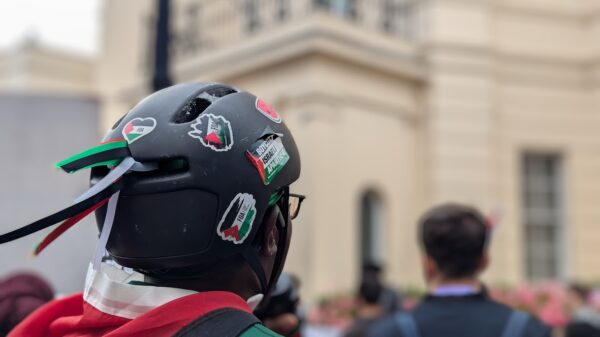Staff writer Charley Dennis reviews Dune part II emphasising how the development of female characters impacted the film and contributed to its success.
Warning: This review contains major spoilers from the beginning.
The Second Part of Denis Villeneuve’s Dune should be hailed as the beginning of a new age for science fiction adaptation. This undoubtably inspired and modern adaptation of the rest of Frank Herbert’s 1950s Novel ‘Dune’ has achieved one best IMDB film ratings of all time. Following on from the slightly less received Part One, this sequel has proved itself simply off the radical reimagining of the dated female characters of the original novel.
Dune Part One left Paul Atreides (Timothée Chalamet) travelling to the Fremen Sietch following the attack on Arrakis by House Harkonnen. The seizure of the planet and assassination of his father lays the path for his exile into the desert with his Bene Gesserit mother (Rebecca Ferguson) until they are ambushed by a tribe of the indigenous desert people. Part Two continues the story of Paul as he assimilates into Fremen ways of life – while the spice continues to induce his dreams of a destiny dripping in blood and fire.
After Paul embraces his destiny as Muab’dib, the Messiah who will bring forward Fremen revolution and ecological transformation of the planet, he amasses tribes from the south to march on the Capitol. Paul marches his legions towards Arakeen to face both Harkonnen and Saudakaur forces following the arrival of Emperor Shaddam Corrino IV (Christopher Walken). The firing of an atomic missile into the cliff almost makes his victory inevitable as his forces storm the royal chamber to confront the incumbent party. The film concludes with Paul’s victory over Harokonnen heir Feyd-Rautha (Austin Butler) in a dual, and his marriage to Princess Irulan (Florence Pugh) which secures his right to the Padashar throne.
The Story of Dune can be interpreted through innumerable lenses; Villeneuve’s depiction centred the political dynamics and forces of rebellion which are threaded through the original book. This captivating fast-paced interpretation of the novel made for an ideal on-screen adaption – one which has been hailed as ‘The Empire Strikes Back’ of our generation. Something which appears prominent in the fabric of Villeneuve’s rendition is the attention given to building the female characters of the story. Frank Herbert’s original novel is a classic 1950s tale which gives very little attention to its female characters as free agents of his story – they are portrayed, unquestionably, as means to the ends of the male characters.
Villeneuve’s Dune Part Two is striking in the amount of attention it devotes to fleshing out and exploring the equally interesting female characters of its story – something which appeals to both book lovers as well as those disappointed with Zendaya’s screen time in Part 1.
Lady Jessica is by far one of the most ambitious and impressive aspects of this film. The performance of a space witch who’s slowly consumed by religious and psychoactive ecstasy is brilliantly performed by Rebecca Ferguson. Out of the list of female characters in Herbert’s book, this Bene Gesserit is the most prominent – however, she appears merely as an agent of the cultic witch order which is built on stereotypes of dangerous femineity. Villeneuve’s film illustrates this character with a beautiful taste of agency – we are both presented with a lady who appears drowning in the euphoria of the mysterious water of life extracted from juvenile worms, but also conspiratorially influencing the Fremen people towards the prophecy of the Lisan al Gaib.
This image of Lady Jessica which is dangerously ellusive but religiously empowered alludes to female saints of martyrs of the past – ones which continue to inspire and embolden worshippers of today. Albeit somewhat orientalist, the film employs imagery from throughout human history, from the runes on her skin to her embellished head scarf to inspire the iconography of this unforgettable character.
The film does not provide conclusive proof as to whether the legitimacy of religious truths – but rather provides leaves audiences with an understanding of the power of women in religio-political currents (one which can be mobilised for spectacular aims). What is more impressive in this character is her enduring influence even throughout her pregnancy; Lady Jessica is revealed to be pregnant with a child after she first consumes the water of life. The image of pregnant women – with a child alluded to as powerful as the first –travelling through the desert to raise an army is a testament to an unfading feminine aptitude.
The most transgressive and brilliant of Villeneuve’s changes to the Dune novel is the elevation of Princess Irulan (and this is not just rooted in a love for Florence Pugh). In the original novel, Princess Irulan appears at the end of the story constricted as the simple daughter of Emperor Shaddam to be married off as political capital. The character is displayed as nothing but political commodity for both Paul Muab’dib and the Emperor (something which is somewhat rectified in the sequel novel however). Villeneuve’s adaption, however, depicts the character throughout his entire film; the opening scene immediately injects her into the political development which weaves the entire film.
This is seen in its most explicit sense in the scene where the Padashar Emperor consults her for advice on dealing with Muab’dib’s disruption of spice production on Arrakis. This scene presents the emperor as a decrepit and faltering titular head – where Irulan is providing the real strategy of control. Her logistical advice to approach the Fremen carefully as ‘repression only makes a religion flourish’ completely encapsulates the philosophical prose which structure Herbert’s novels. By depicting Irulan as an almost political narrator of the situation on Arrakis allowed Villeneuve to expand her role in preparation for her importance to the later story and provide a more modern feminist depiction of his character.
The character of Chani, the Fremen warrior which we see Paul fall in love with following his prophetic dreams of her in Part 1, is also greatly expanded upon in Villeneuve’s adaption. Much like Irulan, Chani’s character simply plays the role of a means to an end in the Dune novel as a love affair for Paul who does not have the right to protest his final political matrimony. However, this film adaption provides this character with a much more interesting character development. Chani is immediately apprehensive about allowing Paul and Jessica into Fremen ways of life – she is the voice of tradition in rejecting outsiders, but also reason as she is resistant to the beliefs of Paul as the Lisan al-Gaib.
However, throughout the film she witnesses the proficiency of Paul as he quickly adapts to their cultural world as they slowly fall for each other. Their bond in this film immediately suggests a traditional Hollywood romance story which would appeal to broader audiences, however, Villeneuve does so much more with this narrative. As Chani slowly begins to doubt her own unwillingness to believe the prophecy, she begins to worry about the implications of the violence and destruction to come as the Fremen begin to fight for the sovereignty of their planet. This is undoubtable in her dread at the atomic missiles revealed by Gurney Halleck (Josh Brolin) in preparations for the siege on Arakeen. Chani is the only character who Paul reveals his barbarous dreams of a blood-soaked holy war to come – and this expectedly strikes fear into the future of their mission. Depicting Chani as a voice of reason and apprehension provides her agency in the story of warfare on Arrakis – but in some sense, her voice is also the voice of the audience.
At the climax of the film, we witness both Paul’s marriage to Princess Irulan which supposedly secures himself as rightfully heir to the universe. Chani is the only figure in the room which refuses to bow to Muab’dib as the new emperor, instead exiting the scornfully at the fact he has married himself off to the Princess. The more visceral reaction from Chani, as opposed to the novel’s simple implications of disappointment, exercises Chani’s right to be upset at Paul’s betrayal reducing her to a mere concubine. Regardless, the Great Houses rebuke his claim. The film climaxes with Paul ordering the use of atomic missiles on the ships orbiting Arrakis which manifests Paul’s vision of the Holy Jihad (Herbert’s term) of blood and fire to come.
The scene of Chani crouching alone in the desert calling forth a worm to ride emphasises this importance of Chani as she turns away from the prophecy of Gisan al Gaib and the violence to come. She is an emboldened voice of reason whos heart belongs to the desert, understanding the terror which House Atreides as brought to her planet. At first, I was dissuaded by Chani’s resistance to the movement of history but on retrospect, it’s clear that as a watcher I too was under the influence of Bene Gesserit conspiracy of the Lisan al-Gaib. Chani’s fears of being a pawn in of a dangerous political game were undeniably true.
The skill behind Villeneuve’s recentering of these characters is undeniably purposeful; as dethroned Corrino bows to the Muab’dib’s hand the camera flashes the reactions of these three archetypes: the trembling princess, the fanatical witch, and the betrayed maiden. The ternion of these women encapsulates the threads of this legend as it comes to its conclusion: the politically destitute, the politically emboldened and the rejection of the cause.
Denis Villeneuve’s adaption of the second half of the Dune novel is an exhilarating depiction of Frank Hebert’s story of religio-political warfare and its esoteric premonitions of the horrors beyond the desert. One of the most monumental changes of this film is the way it expands and develops the female characters of the story in ways which undoubtably contribute to this masterpiece. As producers continue to the reimagine stories from our past, this level of commitment to emboldening female characters on screen is essential. I encourage everybody to watch the films and read these books – the Dune universe has officially entered the science fiction hall of fame.










